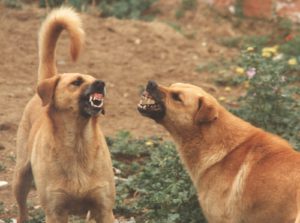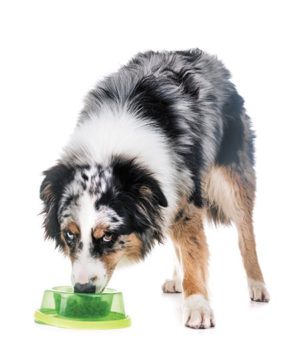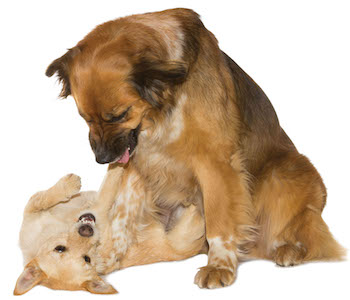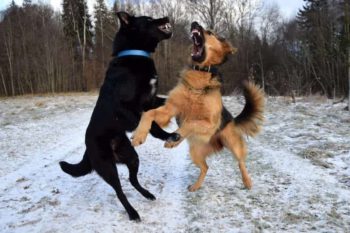Aggression – different forms
 Aggression – different forms shows that types of dog aggression are very varied in nature. It can be inherited, it can be learnt, it can be inter-male or sex related aggression influenced by hormones. It can be environmentally triggered, or learnt in the operant learning mode. Some dogs are just too excited and this can be exhibited by perceived aggression, to us humans anyway.
Aggression – different forms shows that types of dog aggression are very varied in nature. It can be inherited, it can be learnt, it can be inter-male or sex related aggression influenced by hormones. It can be environmentally triggered, or learnt in the operant learning mode. Some dogs are just too excited and this can be exhibited by perceived aggression, to us humans anyway.
When we talk about aggression in dogs, it seems to mean just one thing. A bad tempered animal prone to biting and malicious behaviour. But the worst fear for us, is the possibility of being attacked and bitten. As always, we are putting the human stamp on this word. Aggression, as we see it, is not how it is in the dog’s mind.
Different forms of aggression
The main forms of aggression in dogs are as follows:
- Dominance aggression.
- Possessive aggression which includes competitive aggression and sibling rivalry.
- Fear aggression which includes pain induced.
- Protective aggression which includes territorial and maternal aggression.
- Inter-male aggression.
- Predatory aggression.
- Idiopathic aggression.
- Learned aggression.
I will talk about three of these types of aggression here. More about aggression will be posted in due course.
 1. Dominance aggression
1. Dominance aggression
Dominant Aggressive Dogs – “Dominance in the context of biology and anthropology is the state of having high social status relative to other individuals, who react submissively to dominant individuals. The opposite of dominance is submissiveness. Dominance hierarchies are found in many animals, including primates such as human beings”. This is from www.reference.com
This dog is guarding his food, giving the ‘whale eye’. Watch your step with this look. This dog will likely strike if you go any nearer his food. Dominant aggression in dogs is manifested by aggressive responses to specific situations which are all related to control. With dogs that are naturally dominant, the behaviour of dominant aggression usually rears its head between 1 and 3 years of age.
The leader of the pack
I really don’t think that dominant aggressive dogs are as common as most of us think. In wolves, the most dominant in the pack will gain the place of pack leader. He doesn’t necessarily have to be exceptionally aggressive to attain this position. He does, however, need a naturally dominant demeanour, which other members of the pack instinctively recognise. This positive energy and self confidence radiating from this special wolf, will elicit him to be ‘elected’ by his pack for the leadership role. They will willingly follow this wolf, the best candidate to keep the pack in good shape.
 2. Possessive aggression
2. Possessive aggression
Sibling rivalry is a form of possessive aggression and can occur when two pups are of similar dominance traits. Most commonly, dogs resemble each other in size, age and sex. The triggers for aggression usually eminate from possession of toys, food, best sleeping places and striving for their human owner’s attention. If two dogs of similar energy, same sex and dominant tendencies play fight, this can easily turn into a full blown battle. Unless one dog gives in and submits to the other, both dogs will fight to gain dominance
3. Inter-male aggression
It seems to be in a male dog’s genes to exhibit a fighting tendency because of early masculinisation of the pre-birth pup’s brain. This neonatal event gives rise to the surge of testosterone as the dog matures. But it’s not just dogs that have this predisposition to fight…
Two entire dogs
The sight and/or scent of another male dog can cause this aggression, particularly if both dogs are entire. Castration for inter-male aggression can much improve this type of behaviour and is the possible solution.
Don’t interfer with hierarchy
Owners often exacerbate the situation by their intervention. It is not a good idea to think in terms of equality with dogs. They don’t expect equality and know nothing of it. The ‘underdog’ is not a lesser dog in their eyes but more a dog of a different status. So if you have two dogs and you ‘compensate’ by fussing the underling more than the dominant dog, you will just make matters worse.
An example
A good example is of two labrador retrievers one older than the other. The elder of the two was top dog, until the younger dog decided he would vie for position. He took over the dominant role. The owners did not notice the change in ‘leadership’ and carried on as normal, giving first attention to the older dog. Fighting broke out and the episodes were vicious. The owners sought the help of a dog behaviourist, who worked out what was going on. She advised that now the younger dog should be given first attention. All fighting between the dogs stopped.
 No democracy in canines
No democracy in canines
There is no such thing as democracy in the canine world. There minds work differently. This is something we as dog owners struggle with and if we don’t realise what’s going on, it can lead to some nasty fights and damage or worse. Hierarchy must be observed and treated accordingly.
Is neutering the answer?
According to an article in Agriculture Veterinary Science Nutrition and Natural Researches Oct 2010 ‘Evaluating the benefits and risks of neutering dogs and cats’ by Brennen A Mckenzie – “Most studies have found intact male dogs to be disproportionately involved in aggressive behavior, particularly interdog aggression. Others have reported marked reductions in aggression and other problem behaviors in male dogs as an effect of castration. In one study, roaming behavior decreased 90%, aggression between males decreased 62%, urine marking decreased 50%, and mounting decreased 80% following castration, and several other studies have found similar results. Some studies have also reported intact dogs to be more likely to bite humans than neutered animals. One study of dog-bite related fatalities found the vast majority of these incidents involved male dogs and intact dogs.”

Who doesn’t fear an aggressive dog? I can’t even begin to imagine my leg being bitten by a dog.
IIt is interesting to learn of sibling rivalry in dogs. I thought that it is only found in humans.
I am also a dog owner but I have not seen any type of aggression with our family dog other that protecting his food from other dogs. I am just wondering about aggression influenced by hormones, what to do in such situation?
This is an eye-opening article. Thank you for taking the time.
Hi Carol and yes, an aggressive dog is very scary. Understanding what the dog is thinking, makes it less so because you then know how to deal with that aggression. The fact that your dog does protect his food at all, gives you an idea how the behaviour can progress to being protective over food, especially with children, who often have no clue that the dog is sending signals about his food guarding. 70% of bites are suffered by children.
As for hormones, they do have a profound affect on behaviour and vica versa and that includes aggression. The brain gets information from the senses and passes it on to the hypothalamus. This organ is connected to the brain’s hormone producing pituitary gland.
This is a large subject in its own right. Suffice to say, pups need to be exposed to sensory stimulation when they’re young. Noises, flashing lights, balancing, handling by humans, play with siblings and/or other dogs, knowledge of cats, birds and as many other animals they will meet as they grow into adulthood. These lucky pups will grow stronger, be more stable and better cope with strange and unexpected situations. All because of the hormonal feedback from early experiences.
These dogs will be able to deal with new surroundings and activities without panicking or freezing. Instead they will have a healthy interest in new things and explore, investigate and examine without fear. This vital period of sensory stimulation is up to 16 weeks of age. Many problem behaviours experienced by a dog will be to do with his early upbringing. Hence the massive problems that occur in dogs raised in puppy farms, sold in pet shops or from breeders who have not bothered to do any socialising during the first weeks of a pup’s life.
I didn’t know there were all these different types of aggression in dogs. I have two little chihuahuas and I noticed that one of them is showing the progressive aggression trait. My one dog tries to bite my other one whenever she wants to jump up on the couch to sit with me. Going forward, I will try not to intervene. I try to give both dogs equal attention, but sometimes favor the more cuddly one when sitting on the couch. This makes the other one mad. I’ll have to take turns when spending time with them. Thanks for this article!
Hi there Hillary, yes your chihuahuas will have a ‘pecking order’. Dogs don’t know about equality so for your dominant dog, feed him first, pat him first when you come home etc.. It is difficult I know, but you can still give the love and attention to the submissive dog. It is best for the two of them to exist peacefully together if you observe the rules they themselves have already set up. If you don’t, you could induce the dominant one to be aggressive towards the submissive one. Just make sure that at all costs, you are the one in charge of both of them.
Interesting insights into behaviors that are normal to dogs, but can be perceived as aggression by us. We had a Great Dane once that was the sweetest most gentle animal, but learned to be hyper-protective of our back yard. (I later found that this behavior was a result of some neighborhood kids that were taunting her to cross the electric fence in our yard).
Out in public she was an angel – she would nuzzle and lean on you – little kids could hang on her – everyone was her friend, but at home she would bite any stranger that wandered into our yard. She was very territorial.
It’s helpful to understand how and why dogs show aggressive behavior. We have a Great Dane and she is normally very gentle and amiable towards other dogs. However if I notice her staring at another dog I’ll distract her to pull her attention away from the other dog. That staring can be a nonverbal challenge. If her head drops, the hair on her back stands up and the tail isn’t wagging, it could be trouble. It’s best to break it up before it escalates.
You listed Idiopathic aggression at the beginning of the article. I’ve not heard of this – what does that look like?
Hi Dave, yes you have to be aware of youngsters, they can tease dogs to distraction. This is likely why 70% of bites are suffered by children. Her behaviour could have been caused by this taunting.
Yes, staring is threatening behaviour as far as dogs are concerned. That’s why it is best to look away from a strange dog. With visitors, no talk, no touch and no eye contact is good advice if they have not met your dog before.
As for idiopathic aggression, this just means that the cause of the aggression is unknown. It may be inherited, but it’s anyone’s guess. Ever been told you have an idiopathic type of disease? This means the doctors don’t have a clue what’s wrong with you! Idiopathic aggression is classed as being difficult to eradicate, purely because the cause is not known.
Hi ches,
Thanks for giving this kind of useful & unique article.
Dogs are so familiar with pet animals in our society. But we have to gain enough information about dogs, otherwise it can harmful to us. This article showed the aggression of dogs. Where the author analysis the much kind aggression of dogs. In this article, I know about Possessive aggression of dog. I have a question that can a dog kill another dog with it’s possessive aggression?’
Hi Snigdha, generally dogs are peaceful animals. They do show aggression sometimes, but they show warning signals. Unlike humans who will kill someone without warning, dogs always give you a hint if they don’t like something you’re doing. The problem is when two dogs are equally aggressive or dominant, then you could have a potential fight. If one shows submission then it is often a peaceful ending.
There are occasions though when a dog, say a Pit Bull, has been taught to be aggressive, even to a submissive dog. So most aggression in dogs can be put down to how they have been brought up and trained. A Pit Bull or other strong breed can be as sweet natured as a Beagle or Bichon Frise, if it is socialised, habituated and trained kindly with calmness and patience.
With strong breeds and/or dominant dogs, you MUST be the leader. If the position of leader is vacant, because the owner is weak in the dog’s eyes, some dogs will willingly try to fill that position, with disastrous concequences.